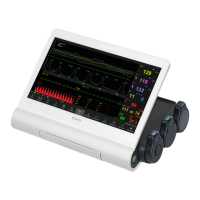F15 Series Fetal & Maternal Monitor User Manual WI-FI Networking and Instructions
- 179 -
As shown in the above figure, channel 1 and 6 strongly interfere with the AP. In this case, the hospital
needs to adjust the channel that interferes with the AP, remove or close the AP. Otherwise, dropouts
will happen during data transmission.
Step 2: Use the PC host for PING test:
The transducer is on the monitor, and by connecting to the AP, the PING test is as follows:
C:\Users\Administrator>ping 192.168.1.166 –n 10
Ping 32-byte data from 192.168.1.166:
Response from 192.168.1.166: byte=32, time=44ms, TTL=128
Response from 192.168.1.166: byte=32, time=20ms, TTL=128
Response from 192.168.1.166: byte=32, time=19ms, TTL=128
Response from 192.168.1.166: byte=32, time=14ms, TTL=128
Response from 192.168.1.166: byte=32, time=11ms, TTL=128
Response from 192.168.1.166: byte=32, time=27ms, TTL=128
Response from 192.168.1.166: byte=32, time=44ms, TTL=128
Response from 192.168.1.166: byte=32, time=20ms, TTL=128
Response from 192.168.1.166: byte=32, time=18ms, TTL=128
Response from 192.168.1.166: byte=32, time=32ms, TTL=128
Ping statistical information of 192.168.1.166:
Data package: sent=10, received=10, lost=0 (0% lost),
Estimated time (in milliseconds) for round trip:
Shortest=11 ms, longest=44 ms, average=24 ms
Network delay = 44ms; meet the requirements;
Network jitter = max (44-11, 44-24) = max (33, 20) = 33ms; meet the requirements
Take the transducer to the position where the pregnant woman is doing the fetal monitoring. Pass the
PING test as follows:
C:\Users\Administrator>ping 192.168.1.166 –n 10
Traditional 510(k) of Fetal & Maternal Monitor
014_14.1_F15_Series_User_Manual

